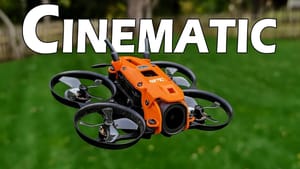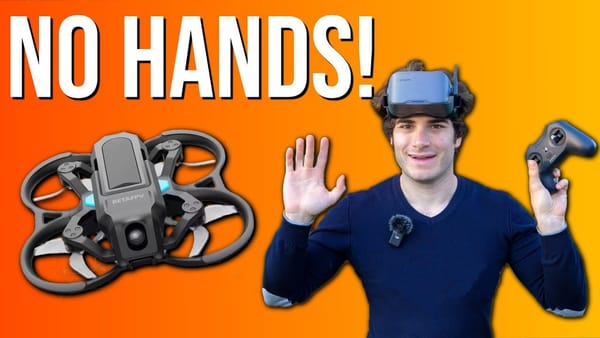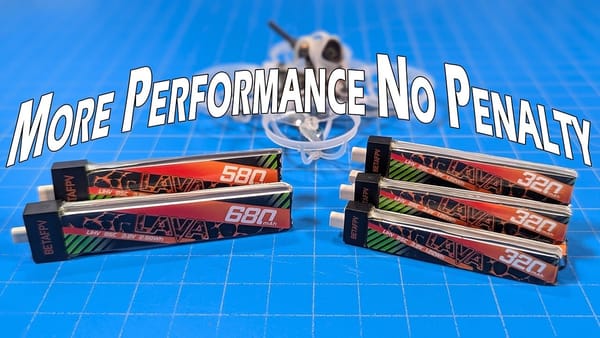Small whoop builders now choose between two cameras for a single lightweight frame. The choice affects noise, stability, and whether the footage suffers from jello or unexpected throttle kicks.

The Pavo Pico II supports both DJI O4 Lite and O4 Pro assemblies. That flexibility forces a practical question: which camera actually suits this tiny 2S whoop?

TL:DR
O4 Lite on the Pico II delivers the cleanest footage with almost zero jello and better real-world feel for gentle flying. O4 Pro adds weight and noise, and the Pico II lacks the grunt to use it to full effect. For aggressive acro or heavier payloads, choose a slightly bigger frame.

What arrives in the box and why it matters
The kit includes extra Gemfan 45mm tri blades, tools, a USB-C adapter for the flight controller, spare screws, grommets, soft mounts, and a silicone adapter to fit DJI Pro antennas. BetaFPV also sells coloured prop variants and an alternate grey O4 Pro mount.

Hardware revisions vs the original Pico
The new Pico II is substantially reworked. The plastic pusher frame is stiffer. The 1.5mm carbon rails are wider. Mounting holes now accept both O4 Lite and O4 Pro assemblies. They kept the same 45mm props.

The motors still register as 1102-14000 KV, but BetaFPV fitted bigger magnets. The firm claims about 10 percent more power and efficiency. The on-board F4 all-in-one flight controller now runs 2S to 3S logic with 20A ESCs and an integrated ExpressLRS 2.4GHz receiver. Crucially, a stout battery eliminator circuit maintains camera power during voltage sag.
Mounting system and modularity
The camera assembly is interchangeable in minutes—four screws and a connector swap. That modularity is smart. It lets operators move an O4 assembly between platforms. Expect compatibility with future BetaFPV models if they continue this approach.
First impressions: O4 Pro on the Pico II
Mounted with the O4 Pro, the Pico II weighs in around 78 grams dry. The flight feels stable in angle mode but carries surprising high-frequency noise. The motors draw moderate current—around five amps instantaneous during light punch-outs—but the package lacks the reserve thrust for crisp acro.
In acro the tune feels loose. The frame and props favour efficient slow flight, not sharp manoeuvres under a heavy camera. Expect throttle hunting and occasional unexpected throttle application during fast inputs. If the plan is to shove an O4 Pro on a tiny platform for aggressive flying, a larger Pavo 20 Pro or a Gephardt Darkstar 22 is a safer bet.
Second run: O4 Lite on the Pico II
Swap to the O4 Lite and the drone sheds weight down to about 53 grams. The soft-mounted assembly reduces jello dramatically. Angle mode feels floatier and much quieter. The O4 Lite onboard this frame produces perhaps the best O4 Lite experience the tester has seen on a tiny whoop.
Some flight irregularities remain—occasional darting during maneuvers and a tendency to apply throttle unexpectedly in aggressive inputs. Still, for slow cinematic flying and indoor sessions, the setup is smooth and efficient. Most importantly, the O4 Lite avoids the jello that plagues many tiny whoop builds.
Battery life and practical limits
With a 2S 550mAh battery the Pico II manages roughly four to five minutes depending on how hard one pushes it. The O4 Pro configuration lowers endurance due to extra weight. The O4 Lite setup shows better efficiency because of the lower mass and the 45mm props’ wider blades.
Tuning and firmware notes
The flight controller is F4 based and ships with standard tuning that favours stability over aggressive authority. If the drone feels loose in acro, several remedies exist: tighten PID gains, adjust D-term filtering, or tweak throttle expo. Fixing jello is harder than tuning out loose flight—hard mounts and stiffer frames remain the fastest way to kill micro-vibration.
Camera restrictions and workflow
The Pico II requires the original DJI camera assembly to mount O4 cameras. That choice prevents easy swaps to a wide-angle lens or filter. Pilots who prefer wide-angle optics for dynamic framing must either accept post stabilisation on a four thirds sensor or use a different platform.
Verdict: pick your mission, then pick the camera
Choose O4 Pro only if the mission demands the extra image fidelity and the operator accepts thicker noise, shorter flight time, and limited acro capability. For most tiny whoop use cases—indoor exploration, smooth slow cinematic runs, or when jello is a nonstarter—the O4 Lite is the pragmatic winner.
Recommendations
- Use O4 Lite for best shake-free footage on a tiny whoop and longer flight times.
- Avoid O4 Pro on Pico II if acro or low noise matters; pick Pavo 20 Pro or Darkstar 22 instead.
- Fix tuning before blaming hardware—PID adjustments often cure darting and unexpected throttle events.
- Keep spares—propellers and soft mounts matter; the kit includes useful extras.
FAQ
Will the Pico II run on 3S if the ESC supports it?
Hardware allows 2S to 3S voltages, but the motors are spec’d for 2S use. Running 3S increases stress and noise and may reduce reliability under heavy camera loads.
Does the Pico II suffer from jello with O4 Lite?
Notably, the soft-mounted O4 Lite showed no obvious jello on test flights. This build avoids the typical O4 Lite jello issues many tiny whoops suffer.
Can I mount a wide-angle lens or filter on the DJI assembly?
Not directly. The Pico II requires the original O4 assembly, which limits external optics. Wide-angle requires either post stabilisation or a platform that accepts custom mounts.
How long should flights last on 550mAh 2S?
Expect around four to five minutes with mixed flying. O4 Pro setups reduce endurance; lighter O4 Lite runs extend flight time slightly.
Takeaway box
O4 Lite on Pico II gives the best footage-to-weight trade-off—less jello, better efficiency.
O4 Pro adds image headroom but punishes the tiny frame with noise and limited throttle reserve.
Tune first—fix loose handling with PID and filtering before replacing hardware.
If you want power choose a slightly larger platform built for the extra payload.
This article was based from the video What FPV Camera should you use on the BetaFPV Pavo Pico II?






